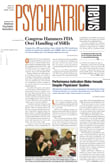It's a turbulent roller coaster ride for many bipolar patients—frequent swings between a normal mood, depression, and mania. Yet what types of bipolar patients become these “rapid cyclers”?
Some insights have emerged from a multicenter study funded by the National Institute of Mental Health that was launched several years ago and is purportedly the largest long-term study of the course and outcome of bipolar disorder ever undertaken (Psychiatric News, April 20, 2001).
The findings are reported in the October American Journal of Psychiatry.
The study is called the Systematic Treatment Enhancement Program for Bipolar Disorder. The goal is to enroll 5,000 patients in it. However, data from the first 500 patients enrolled in the program have been used to obtain insights into rapid cyclers. Here are some of the major findings culled from those data:
•
About 20 percent of bipolar patients are rapid cyclers. According to the DSM-IV definition, rapid cyclers experience four or more depressive, manic, or hypomanic episodes a year.
•
Rapid cyclers have a greater severity of illness than do non-rapid cyclers. For example, rapid cyclers experience on average eight depressive episodes a year, whereas non-rapid cyclers average only one, and rapid cyclers incur on average nine hypomanic or manic episodes a year, compared with only one for non-rapid cyclers.
•
Rapid-cycling patients tend to be more impaired and depressed than non-rapid cycling patients. Depression, in fact, seems to be the most important characteristic of rapid cycling, more so than continuing or recurrent mania or hypomania.
•
Rapid cyclers experience onset of illness at an earlier age than do non-rapid cyclers—on average about three years earlier.
•
Rapid cyclers are more likely to be women than men.
•
Rapid cyclers do not experience any more psychosis than non-rapid cycling patients, suggesting that rapid cycling is more a consequence of mood instability than of psychosis.
“Probably the result that surprised us most was the association between rapid cycling and younger age of onset of bipolar illness,” Christopher Schneck, M.D., an associate professor of psychiatry at the University of Colorado Health Sciences Center and the lead investigator in this arm of the study, told Psychiatric News. “Many previous studies had found rapid cyclers to be older than non-rapid cyclers.... The finding makes us wonder if young age of onset is a risk factor for developing rapid cycling.”
One of the study results that Gary Sachs, M.D., director of the bipolar clinic and research program at Massachusetts General Hospital and the principal investigator of the entire Systematic Treatment Enhancement Program, would like to highlight is the controversial issue of gender in rapid cycling.
“We've gotten results that are similar to other studies that have done it right,” he said, “and I think we're proud of that.”
“All in all,” he added, “I think we have shown that this is a particularly pernicious and relatively common form of bipolar disorder that deserves to be a subject of research in its own right.”
Schneck concluded, “I think the implications of the study for clinical psychiatrists are perhaps to be more suspicious of `rapid-cycling potential' in those patients who experienced early onset of the illness. This may then have implications in being more cautious in using antidepressants, as these patients may be even more vulnerable to cycling.”
Am J Psychiatry 2004 161 1902
